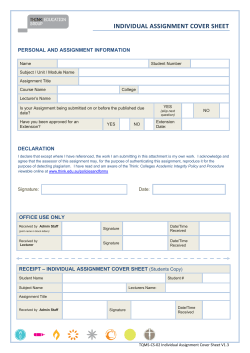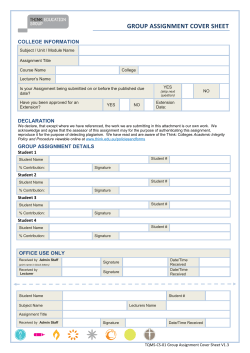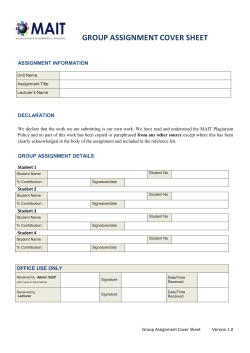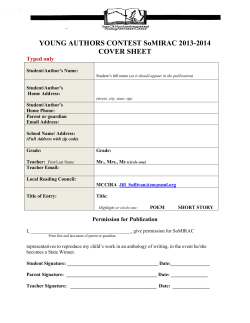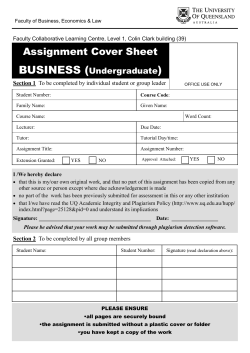
( ) ( )H
Electronic Supplementary Material (ESI) for Molecular BioSystems.
This journal is © The Royal Society of Chemistry 2015
Compound signature detection on LINCS L1000 big data
Chenglin Liu1,2,3, Jing Su1,*, Fei Yang1, Kun Wei1, Jinwen Ma3 and Xiaobo Zhou1,*
1
Center for Bioinformatics and Systems Biology, Department of Diagnostic Radiology and
Comprehensive Cancer Center of Wake Forest University, Wake Forest School of Medicine, WinstonSalem, NC, 27157, USA
2
School of Life Sciences & Technology, Shanghai Jiaotong University Shanghai 200240, China
3
School of Mathematical Sciences and LMAM, Peking University, Beijing 100871, China
* To whom correspondence should be addressed. Tel: 336-713-1789; Fax: 336-713-5891; Email: JS
jsu@wakehealth.edu and XZ xizhou@wakehealth.edu
Method 1: The GMM Model.
To deconvolute the overlapped peaks of the distributions of the L1000 analyte fluorescent intensities,
we assumed that the fluorophore intensities of each analyte type (corresponding to a specific mRNA
type) subjected to a Gaussian distribution. The distribution of the mixture of analytes GeneH(i) and
GeneL(i) corresponding to the expression levels of GeneH and GeneL, respectively, should subject to a
two Gaussian mixture, with the proportion of 1.25 to 0.75:
f ( x) p L , L (1 p ) H , H
(1)
where f (x) is the cumulative distribution function of the analytes GeneH(i) and GeneL(i) of the same
analyte color i, x is the fluorescent intensity value (i.e., the measure of the gene expression levels) of
beads, and N (,) is the cumulative Gaussian distribution function of the fluorescent intensity of an
analyte type. The parameter p was initialized as 0.375 based on the prior knowledge of bead portions.
The objective function for GMM optimization was:
argmin f ( x) p L , L (1 p ) H , H F
2
(2)
L , H , L , H
Parameters
L , H , H ,
and
H
were initialized by the fuzzy c-means clustering [10]. The
expression levels of the two transcripts were determined by solving L and
the objective function using the Nelder–Mead method[11].
Page 1 of 14
H
through optimizing
Method 2: The EGEM score.
Figure S1. EGEM score construction. The up- and down- DEGs
after a gene knockdown treatment are used as two feature sets.
The locations of up- and down feature sets in the ascendant- and
descendant-sorted gene list after a compound treatment are
measured by Kolmogorov-Smirnov statistic. The value is
normalized by the total size of up- and down feature sets.
We defined the EGEM score to describe the similarity between the treatments of a compound and
an shRNA targeting a gene using the mutual enrichment of their resultant differential expressed
landmark genes. The EGEM metric was derived from the rank-based gene set enrichment analysis
(GSEA) [1] and the connectivity analysis[2]. Compound treatments could be taken as “phenotypes”
and the differentially expressed genes (DEGs) of a single gene knocking down treatment as a
“signature gene set” in the GSEA terminology. The EGEM metric enabled gene set enrichment
analysis against the LINCS target gene reference library.
The construction of EGEM score was shown in Figure S1. A signature gene set of a target gene,
which was composed of
regulated and
t down
n
DEGs after the knockdown of a target gene, among them
tup were up-
down-regulated. DEGs were detected according to the LFCs of the L1000
landmark genes using 1.5 IQR (interquartile range) as the threshold, which was robust against
outliers. For a small molecule compound, two lists of landmark genes were used to represent the
patterns of the compound-induced L1000 gene expression changes, one (
and the other (
pdown ) descendantly based on according to the LFCs.
Page 2 of 14
pup ) sorted ascendantly
, such, p1 ( j ) and p 2 ( j ) were the positions of the jth up- and down-regulated DEGs, respectively,
in their corresponding probe gene lists. The EGEM score was defined as
i
j
p (i ) i
p ( j) j
egem max
1
2
max
i 1:t1
j
1:
t
2
t1 t2 2n t1 t2
t1 t2 2n t1 t2
(3).
The EGEM score ranges from -1 to 1. The absolute value of an EGEM score represents the
enrichment degree. The positive or negative sign of an EGEM score indicates that the change of gene
expression pattern due to knocking down the corresponding gene is similar or reversely similar to that
induced by the drug treatment. The statistical significance of an EGEM score was determined by t-test
against permutations of 100 times. The EGEM scores were kept only if the associated p-values were
less than 0.05 and otherwise were set to zero.
We constructed an EGEM matrix by pairwisely calculating the EGEM score between each
compound and each knockdown gene. We assumed that both the positive and negative EGEM
scores followed normal distributions. We also assumed that the EGEM matrix was sparse by
observing the fact that, among the 3,000 proteins, a compound usually only targets a limited number
of them. Hence, we chose the EGEM scores with single-side p-values less than 0.05. Other scores
were forced to zeroes.
Page 3 of 14
Method 3: The NMF algorithm.
The basic NMF problem can be solved according to the multiplicative update rules proposed by Lee
and Seung[3]:
Theorem 1 The Euclidean distance ‖‖
A WH is non-increasing under the update rules:
H rj H rj
(W T A) rj
T
(W WH ) rj
( AH T )ir
.
(WHH T )ir
, Wir Wir
S1
The Euclidean distance is invariant under these updates if and only if W and H are at a stationary
point of the distance.
We solve the csNMF problem according to Eq. S1. Construct the following matrixes A , W and H so
that:
As
A Ar
O1 m
Ws D
On k
Wr D ,
e1k P
On k
e1k
Ws
W Wr , H H
e1k
Ik
P ,
where e1k R1k is a row vector with all components equal to one and 01 n is a zero vector, I k is an
identity matrix of size k k and 0k m is a zero matrix of size k m .
Then, the objective function can be written as:
1
f (W , H ) ‖‖
A WH 2 .
2
According to Eq. S1, the problem of csNMF can be solved by the multiplicative update rules:
H rj H rj
(W T A) rj
(W T WH ) rj
,
that is:
H rj H rj
(WsT A1 WrT A2 ) rj
(WsT Ws H WrT Wr H ek k H ) rj
Wir Wir
.
S2
( AH T )ir
,
(WHH T )ir
that is:
Wirc Wirc
( Ac H T W c DP )ir
,
(W c HH T W c W c PP )ir
S3
where W Ws , Wr .
c
Determine the optimal signatures. We constructed the adjacency matrix
𝐶𝑀(𝑟,𝑗) =
{
1, if
{
𝐶𝑀 ∈ 𝐶𝑡(𝑊 ),𝐶𝑡(𝑊 ),𝐶𝐻
𝑋(𝑟,𝑗) ‒ 𝑚𝑒𝑎𝑛(𝑋(𝑟,:))
> 𝑡ℎ𝑟𝑒𝑠ℎ𝑜𝑢𝑙𝑑;
𝑠𝑑(𝑋(𝑟,:))
0, others
𝑆
𝑅
}:
S4
to determine the clustering results. Since the optimization might converge to local minimum, in order
to decompose the EGEM matrix into 𝑘 clusters, we permuted the original orders of the EGEM matrix,
Page 4 of 14
repeated the optimization process for 30 times, and used the average of the calculated adjacency
̅
matrixes 𝐶𝑀,𝑘 to determine the final clustering results (Eq. S5)
̅ (𝑟,𝑗) =
𝐶𝑀,𝑘
{
𝑁
∑𝐶
1, if
𝑀,𝑘,𝑢(𝑟,𝑗)
𝑢=1
𝑁
0, others
> 0.5;
S5
Determine the optimal signature number. We used the cophenetic correlation coefficient (CCC)
method [4] to measure the stability of the clustering results and thus to determine the optimal cluster
number. Briefly, the cosine similarity[5] between each adjacency matrix 𝐶𝑀,𝑘,𝑢(𝑟,𝑗) and the average
̅
𝐶𝑀,𝑘
. The cosine similarity was chosen over Pearson’s correlation because it has been shown
insensitive to zeroes [6] which were abundant in adjacency matrixes.
Adjacency matrix construction and signature number determination
After performing csNMF approach, EGEM matrix is decomposed into weight and coefficient matrixes.
The next is to assigning the elements (compounds and genes) to different signatures. This fulfils by a
adjacency matrix C, which is a 0-1 matrix of size k x n, Ci , j 1 if element j is clustered to signature i,
and Ci , j 0 if not [7]. As to the adjacency matrixes CM (M is V, t(W1), t(W2) of the csNMF results, t(M)
is the transpose matrix of M), if the value of one element j is of the top p quartile of signature i,
CiM, j 1 , otherwise CiM, j 0 . Since the objective function of csNMF is not convex in W1, W2 and V,
the algorithm may converge to different local minimums on each run of optimization, based on
different random initial conditions. Thus, different adjacency matrixes are obtained based on different
initializations.
matrix
However, it is estimated that 20-100 runs suffice for a stable average adjacency
C [4]. Hence, we randomly reorder the compounds and genes of EGEM matrix 30 runs, and
perform csNMF.
Only if one element related with one signature in at least 15 runs is one in the
average adjacency matrix, otherwise, it is zero. That is to say,
1 if C u 15
ij
Ci, j u1..30
0 else
Page 5 of 14
,
where u is the index of run times, u [1 : 30] .
Another crucial matter of csNMF is the chosen of signature number k, which needs to be
determined prior to optimization. Suppose the clustering of k signatures is strong, the assignments of
genes and compounds should vary little among different runs. Hence, we set a list of candidate
signature numbers k r K . Then, we compute the average consistence degree as to each signature
number kr. A consistence degree relating to a signature in the uth run based on kr signature number is
defined as the cosine value between the adjacency matrix value of that signature of run C
u
and
those of the average adjacency matrix C . The average consistence degree of kr is the average
consistence degree of all the signatures and all the 30 runs. Hence, the stronger clustering is the one
with larger consistence degree, and the corresponding k is the best signature number among k r K .
Page 6 of 14
Additional Table S1: Algorithm for EGEM and csNMF
Algorithm: The Algorithm of compound signature discovery
1. Determine the up- and down- DEGs after the gene perturbations.
2. Construct EGEM matrix based on the DEGs after the gene perturbations and the gene
expression patterns after the compound treatments.
3. Estimate the significance of EGEM scores and adjust the EGEM matrix.
4. Construct the PPI matrix according to the genes in the EGEM matrix.
5. Construct the objective function of csNMF, and provide the candidate number of signatures
𝑘as well as the replication number 𝑁.
6. while do
while do
Disorder the genes and compounds of the EGEM matrix randomly.
Solve the csNMF problem based on Eq. S2 and Eq. S3.
Build the ith connectivity matrix CH , Ct(Ws), Ct(wr).
end while
Determine the signature detection results based on k.
Calculate the consistence degrees based on k.
end while
7. Determine the stable signatures of each 𝑘 based on Eq. S5
8. Determine the optimal 𝑘 and obtain the signature detection result.
9. The Biological analysis of each signature.
Page 7 of 14
Additional Table S2 : Correlations of inhibitors of Sig 2.
Combination
(1,2)
(1,3)
(1,4)
(2,3)
(2,4)
(3,4)
randMean
randSD
Cov(target)
0.79
0.81
0.04
0.74
0.04
0.05
0.10
0.17
Cov(exp)
0.35
0.26
0.21
0.18
0.16
0.20
0.08
0.14
Cov(egem)
0.47
0.49
0.38
0.52
0.43
0.46
0.14
0.21
1. “ALW-II-38-3”; 2."ALW-II-49-7”; 3. “QL-XI-92”; 4. “CP724714”. Cov(target) was the correlation of the
two inhibitors’ interacting rate to 450 kinases. Cov(exp) was the correlation of gene expression pattern
after two inhibitors’ perturbagens. Cov(egem) was the correlation of EGEM scores of two inhibitors.
randMean and randSD were the average and standard deviation of correlation of each two inhibitors
combination.
Page 8 of 14
Additional Figure S2: Comparison of EGEM-based and experimentally measured kinase inhibitor target
similarity.
Cov(kinase target)
1
0.8
0.6
0.4
0.2
0
0.35
0.4
0.45
0.5
0.55
Cov(EGEM)
Figure S2. Comparison of EGEM-based and experimentally
measured kinase inhibitor target similarity. Cov(EGEM): the
similarity among kinase inhibitors ALW-II-38-3, ALW-II-49-7, QLXI-92, and CP724714 predicted by the covariance of their EGEM
scores. Cov(kinase target): the similarity among their direct
kinase inhibitor assayed by KINOMEscan®.
Page 9 of 14
Additional Table S3: The p-value of target gene GO similarities of each signature
Sig 1
Sig 2
Sig 3
Sig 4
Sig 5
Sig 6
BP
0.15
0.28
0.71
2.66e-5
0.04
0.24
MF
0.18
0.01
0.90
3.68e-3
0.49
0.77
CC
0.11
0.04
0.72
9.49e-3
0.02
0.76
GO similarities were evaluated in three categories: the biological process (BP), the molecular function
(MF), and the cellular component (CC). Statistically significant similarities (≤0.05) were labeled in bold
font.
Page 10 of 14
Additional Table S4: Univariable and multivariable survival analysis using compound signatures as well
as conventional clinical features for chemotherapy.
Univariable
Hazard Ratio (95% CI)
Relative risk p-value
Cl
Cu
(z)
age
1
1
1.1
1.9 0.0678
size
1
1
1
1.8
0.101
pam50
1.2 0.44
3.5
0.26
0.343
subtype
0.92 0.29
3.4
-0.25
0.328
lymphnode
2.2 0.99
4.7
1.9 0.0386
ER
0.72 0.38
1.4
-1
0.307
grade
1 0.23
4.6
0.025
0.979
Sig1
0.99 0.53
1.9
-0.04
0.968
Sig2
0.78 0.42
1.5
-0.77
0.443
Sig3
0.95
0.5
1.8
-0.16
0.871
Sig4
2.3
1.2
4.5
2.5 0.00956
Sig5
2
1.1
3.7
2.1 0.0331
Sig6
1.2 0.64
2.3
0.59
0.558
Sig7
0.97 0.52
1.8
-0.088
0.93
Sig8
1.2 0.62
2.2
0.5
0.616
Variables
Multivariable
Hazard Ratio (95% CI)
Relative risk p-value
Cl
Cu
(z)
1 0.98
1.1
1.1
0.25
1 0.99
1
0.68
0.49
0.052 0.0024
1.1
-1.9
0.06
23 0.91 > 100
1.9
0.057
2.8 0.74
10
1.5
0.13
0.33
0.1
1.1
-1.8
0.067
0.41 0.041
4.1
-0.76
0.45
0.55
0.2
1.6
-1.1
0.27
0.98 0.32
3
-0.035
0.97
0.55 0.19
1.6
-1.1
0.28
3.8
1.4
10
2.6 0.0092
1.5 0.56
3.8
0.78
0.43
1.8 0.63
5.4
1.1
0.27
0.96 0.27
3.4
-0.071
0.94
0.46 0.13
1.6
-1.2
0.22
Page 11 of 14
Additional Table S5: Univariable and multivariable survival analysis using compound signatures as well
as conventional clinical features for Tamoxifen treatment.
Univariable
Hazard Ratio (95% CI)
Relative risk p-value
Cl
Cu
(z)
age
1 0.99
1
0.92
0.359
size
1
1
1
6.9 < 0.0001
pam50
1 0.51
2.2
-0.34 < 0.0001
subtype
0.81 0.42
1.6
-1.2 < 0.0001
lymphnode
2.4
1.7
3.3
5 < 0.0001
ER
0.39 0.22 0.71
-3.1 0.00651
grade
5.4
2.3
13
3.9 < 0.0001
Sig1
0.88 0.63
1.2
-0.73
0.466
Sig2
1.1 0.78
1.5
0.5
0.616
Sig3
1.1
0.8
1.6
0.67
0.501
Sig4
1.2 0.83
1.6
0.89
0.372
Sig5
0.93 0.66
1.3
-0.44
0.657
Sig6
0.98
0.7
1.4
-0.14
0.888
Sig7
0.97 0.69
1.4
-0.17
0.866
Sig8
0.84
0.6
1.2
-1
0.303
Variables
Multivariable
Hazard Ratio (95% CI)
Relative risk p-value
Cl
Cu
(z)
1 0.98
1
0.35
0.73
1
1
1
4 < 0.0001
2.1 0.92
4.8
1.8
0.076
0.22 0.067
0.7
-2.6
0.011
1.7
1.1
2.6
2.4
0.018
0.52 0.24
1.1
-1.7
0.097
2.4 0.99
6
1.9
0.054
0.9 0.57
1.4
-0.47
0.64
1.6 0.96
2.6
1.8
0.069
1.3 0.85
2
1.2
0.21
1.4 0.89
2.1
1.4
0.15
0.84 0.55
1.3
-0.82
0.41
0.81 0.53
1.2
-0.95
0.34
1.4 0.84
2.3
1.3
0.2
0.63 0.39
1
-2
0.05
Page 12 of 14
Additional Figure S3: Association between breast cancer compound signatures and clinical traits.
Sig 2 High
Sig 3 High
Sig 6 High
Sig 2 Low
Sig 3 Low
Sig 6 Low
Figure S3. Association between breast cancer compound signatures and clinical traits.
Page 13 of 14
REFERENCES
1.
Subramanian A, Tamayo P, Mootha VK, Mukherjee S, Ebert BL, Gillette MA, et al. Gene set enrichment
analysis: A knowledge-based approach for interpreting genome-wide expression profiles. Proceedings of the
National Academy of Sciences of the United States of America. 2005;102(43):15545-50.
2.
Lamb J, Crawford ED, Peck D, Modell JW, Blat IC, Wrobel MJ, et al. The Connectivity Map: using gene-
expression signatures to connect small molecules, genes, and disease. science. 2006;313(5795):1929-35.
3.
Lee DD, Seung HS, editors. Algorithms for non-negative matrix factorization. Advances in neural
information processing systems; 2001.
4.
Brunet J-P, Tamayo P, Golub TR, Mesirov JP. Metagenes and molecular pattern discovery using matrix
factorization. Proceedings of the national academy of sciences. 2004;101(12):4164-9.
5.
Cheetham AH, Hazel JE. Binary (presence-absence) similarity coefficients. Journal of Paleontology.
1969:1130-6.
6.
Leydesdorff L. Similarity measures, author cocitation analysis, and information theory. Journal of the
American Society for Information Science and Technology. 2005;56(7):769-72.
7.
Mejía-Roa E, Carmona-Saez P, Nogales R, Vicente C, Vázquez M, Yang XY, et al. bioNMF: a web-based tool
for nonnegative matrix factorization in biology. Nucleic Acids Research. 2008;36(suppl 2):W523-W8.
Page 14 of 14
© Copyright 2025
